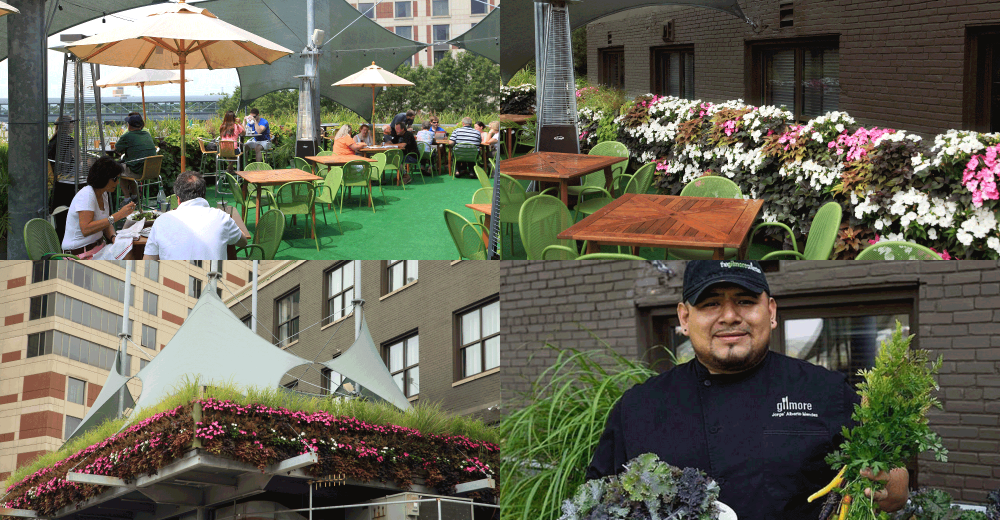1 10
1 10
Green walls or living walls, either attached to an existing wall or freestanding, are structural systems that enable plants to grow as a vertical garden. The lush, leafy greens create a nature-inspired backdrop that can transform a space.
Such a transformation took place a year and a half ago at the Sky Patio at The B.O.B. (acronym for Big Old Building), part of a restaurant complex in downtown Grand Rapids, Mich. The green wall shows off parent company the Gilmore Collection’s commitment to not just sustainability and fresh herbs, but also beautification and connection with the downtown neighborhood.
Green walls can serve many purposes: beautification of an outdoor or indoor dining area, a symbol of sustainability, a source of hyperlocal herbs and veggies, a noise barrier, a privacy screen, a shady spot for sunny days and a sure-fire way to instant outdoorsy ambience.
This is how the Sky Patio at The B.O.B. looked before the green walls were installed. The rooftop patio, accessed through second-floor piano bar/wood-fired pizza restaurant Bobarino’s, had been barren concrete. The potential was there, because the rooftop had good views of the Grand Rapids skyline, but otherwise this was one dull patio. Fast-forward to present day, and it’s a total oasis.
The patio came alive with carrots, kale, Swiss chard, herbs, colorful flowers and more, growing strong into its second summer and now fall. Three double-sided exterior sections of growing annual and perennial plants surround the patio, and five more sections throughout provide a totally green atmosphere where before there was nothing.
“It’s a visual shorthand to the sustainable commitments of the restaurant,” says Alice Jasper, the Gilmore Collection’s director of sustainability. She has overseen the green wall project at the Sky Patio and at other concepts as well. The wall at the Sky Patio was installed in August 2015 using the LiveWall system, a local company.
The Sky Patio’s living wall is visible from the street, creating a new layer of interest and visual marketing for the restaurant, an effect Jasper calls “a hovering garden experience.” She says the most important part of planning a green wall is thinking about the purpose it should serve.
While getting hyperlocal produce is an obvious application of a green wall, most restaurants need a lot more produce than a typical green wall can yield. Many restaurants use just a few vegetables from the green wall, like carrots or kale in salads. More often, mixologists and chefs are using the herbs on the wall for cooking and adding to craft cocktails.
“Figure out what you want its primary function to be,” Jasper says. “If it’s mainly going to be for beautification, it’s more about the ambience. Realistically, for larger restaurants, we’d need a lot bigger live walls to really be a viable source of produce.”
“It doesn’t have to be just for food production,” adds Lori May, LiveWall sales specialist. “For harvesting, that’s great, but people also want it for ambience and color and a focal point. We’ve been doing that a lot lately for beer gardens. And indoor walls are usually focused more on ambience.”
So the Sky Patio’s green wall isn’t meant to be a workhorse producer of veggies, but a few items, like Swiss chard (pictured) make their way onto plates and the herbs get used a lot by chefs and mixologists.
Another key component of a successful living wall is staff buy-in. Maintenance is relatively low (the walls are self-watering and largely a “set it and forget it” operation with an irrigation system of sprinklers that run on a timer). But you still must have someone (preferably with a green thumb) on staff who can keep an eye on the wall.
“Regardless of the purpose of your wall, make sure you have a couple staff members who can recognize plants, realize if it’s being overwatered if there’s been a lot of rain or if it looks dry,” Jasper says. “People assume because it’s self-watering that there’s no maintenance, but that’s not quite true. Plants are living things, and you need to harvest and prune.”
Education for staff is a continuing process. In the beginning of the green wall project, some chefs wouldn’t realize that they could (or should) harvest some of the items. On the other end of the spectrum, some other staff members mistakenly harvested the wall all at once on the first day, leaving just stems. Jasper recommends spending some time training staffers on proper care and harvesting.
“We have a gardener [for the restaurant group] who handles a lot of it, but we’re hoping next year we can have one or two people from each restaurant to be point people who are aware and invested,” Jasper adds.
Aside from the farm-to-table visual connection, green walls can also include annual flowers that can change up the look from year to year.
Another thing to consider about green walls is the light exposure.
“South and west is great, but if you have shade, it could take on a different purpose,” May says. Mint, for instance, grows well in shady spots.
As seasons change, perennial plants are trimmed back, annuals in the live wall are composted and any last harvesting is done. This year, milder fall temps meant that kale was thriving well into November.
Last but definitely not least, living walls can grow a connection with the community. Since the Sky Patio got greener, the vibe has been more conducive to live music and more business, which means more chances to get casual diners interested in the ecosystem, at least during the time they read a table tent while waiting for cocktails to arrive.
“It’s also important to think about the education piece,” Jasper says. “We have QR codes on tabletops with information about the beneficial plants that we have. Let people know, ‘The bees and butterflies are having a hard time; some of the plants you see around you are helping them out.’ Education makes a difference.”

